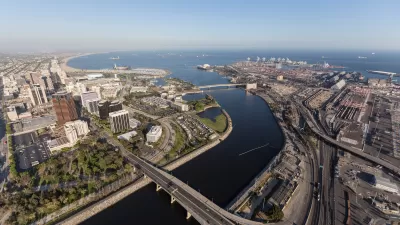In an editorial posted yesterday in Popular Mechanics, national security expert Stephen Flynn argues that Americans are relying on decades-old infrastructure intended for a much smaller passenger and vehicle load.
In an editorial posted yesterday in Popular Mechanics, national security expert Stephen Flynn argues that Americans are relying on decades-old infrastructure intended for a much smaller passenger and vehicle load.
"The fact is that Americans have been squandering the infrastructure legacy bequeathed to us by earlier generations. Like the spoiled offspring of well-off parents, we behave as though we have no idea what is required to sustain the quality of our daily lives. Our electricity comes to us via a decades-old system of power generators, transformers and transmission lines-a system that has utility executives holding their collective breath on every hot day in July and August. We once had a transportation system that was the envy of the world. Now we are better known for our congested highways, second-rate ports, third-rate passenger trains and a primitive air traffic control system. Many of the great public works projects of the 20th century-dams and canal locks, bridges and tunnels, aquifers and aqueducts, and even the Eisenhower interstate highway system-are at or beyond their designed life span."
We have failed both to maintain existing infrastructure and to create a bold vision that should have carried American transportation into the new century.
Most importantly, we are expecting older roads and bridges to support not only a larger number of vehicles, but also a substantial upsurge in vehicle weight and size.
According to the Federal Highway Administration, truck registrations have more than doubled since 1992. Here are the national numbers:
Vehicle Registrations in 2005
Total number of automobiles - 136,568,083
Total number of trucks - 103,818,838
Total number of vehicles – 241,193,974
Vehicle Registrations in 1992
Total number of automobiles – 144,213,429
Total number of trucks – 45,504,067
Total number of vehicles – 190,962,228
These statistics represent the increased use of "trucks" (SUVs, flat beds, minivans) as private vehicles.
Once again, the solution could be to continue to build new roads to sustain an endlessly expending vehicle load. Or we could combine essential road maintenance with serious investment in alternative modes of transportation. That is, invest in rail and smart growth planning to reduce the burden of our car-obsessed lifestyles.

Alabama: Trump Terminates Settlements for Black Communities Harmed By Raw Sewage
Trump deemed the landmark civil rights agreement “illegal DEI and environmental justice policy.”

Planetizen Federal Action Tracker
A weekly monitor of how Trump’s orders and actions are impacting planners and planning in America.

The 120 Year Old Tiny Home Villages That Sheltered San Francisco’s Earthquake Refugees
More than a century ago, San Francisco mobilized to house thousands of residents displaced by the 1906 earthquake. Could their strategy offer a model for the present?

In Both Crashes and Crime, Public Transportation is Far Safer than Driving
Contrary to popular assumptions, public transportation has far lower crash and crime rates than automobile travel. For safer communities, improve and encourage transit travel.

Report: Zoning Reforms Should Complement Nashville’s Ambitious Transit Plan
Without reform, restrictive zoning codes will limit the impact of the city’s planned transit expansion and could exclude some of the residents who depend on transit the most.

Judge Orders Release of Frozen IRA, IIJA Funding
The decision is a victory for environmental groups who charged that freezing funds for critical infrastructure and disaster response programs caused “real and irreparable harm” to communities.
Urban Design for Planners 1: Software Tools
This six-course series explores essential urban design concepts using open source software and equips planners with the tools they need to participate fully in the urban design process.
Planning for Universal Design
Learn the tools for implementing Universal Design in planning regulations.
Clanton & Associates, Inc.
Jessamine County Fiscal Court
Institute for Housing and Urban Development Studies (IHS)
City of Grandview
Harvard GSD Executive Education
Toledo-Lucas County Plan Commissions
Salt Lake City
NYU Wagner Graduate School of Public Service





























